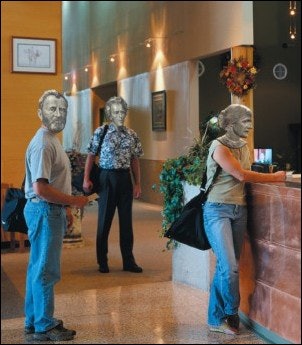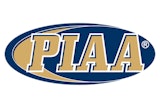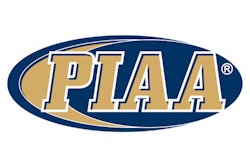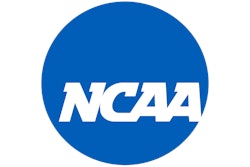By tapping a variety of sources, today's campus and municipal recreation departments can pay for upgrades to programs and facilities all by themselves

According to the "Recreational Sports Expenditures Survey" released in 2002 by Kerr-Downs Research, members of the National Intramural-Recreational Sports Association will spend $5 billion on construction and renovation projects over the next five years.
You might be wondering, just where on earth are they going to come up with the money?
For an increasing number of community and campus recreation programs, the goal is self-sufficiency, and that means most resources are coming from the programs themselves. While self-sufficiency may seem intimidating, particularly if debt-service payments from new or renovated facilities are factors in the equation, it can also be viewed as an opportunity for programs to shape and control their own destiny. In most cases, programs have been able to meet their goals and bring in enough money to cover both operating costs and debt-service payments.
In order to understand the "where" of these revenues, it's important to see how the big picture of recreation has changed over the past 10 years or so. While many factors are commonly identified as the most significant recent changes in the recreation and fitness business, a handful draw frequent attention.
First, expectations among recreation facility users have increased, leading to expanded offerings and, consequently, revenue opportunities. Maureen McGonagle, director of campus recreation at DePaul University, explains, "Increased time demands on students mean more tightly controlled schedules and subsequently higher customer-service expectations. The result is that students are often willing to pay more for better programs and services if they are available when wanted." Second, recognition and support of the health benefits derived from exercise has increased due to expanded research and publicity. Third, public funds that were previously available to college and community recreation departments have been cut, resulting in more incentive to develop alternative revenue sources. Fourth, tax-exempt interest rates have decreased by almost two percentage points over the past decade, permitting more and larger facility investments.
Given so many significant investments in improved recreation facilities and programs, it pays to examine the typical sources that supported the changes. A range of projects completed over the past 10 years is shown in the graphs at left in order to give an understanding of the distribution of revenues, and clearly the types of sources are fairly consistent. Interestingly, though, there can be significant differences in the amount of revenues coming from varied sources, depending upon the type of program.
The graphs also indicate that the largest variance is in student-fee revenue, with the greatest disparity evident between large public campuses and community recreation departments. However, since student fees and memberships both constitute "user fees," they actually represent similar percentages of income for large campuses and municipal departments. Surprisingly, the percentage of revenues from institutional contributions manifests the greatest disparity, with small campuses requiring the most support. The challenge facing small campus programs appears to be that while students remain the primary customers, there typically aren't enough of them to support desired facilities and programs using acceptable fee levels. It would therefore seem that recreational programs are also subject to economies of scale, with larger programs benefiting.
Further review shows differences even between similar-sized programs, so the nature of the target market also plays a role in disparities. These revenue source differences appear to depend more on how much opportunity exists rather than quality of management. Before addressing the apparent impact of the target market, here's a look at what revenues fall into each category:
• Full-time student fees. Revenue from either mandatory or voluntary fees charged to students either by semester or credit hour, depending upon the policy of the supporting institution. While the fee policy may affect the amount of fee revenue available, in almost all cases in which student fees are charged they represent the lion's share of income. State policies regarding auxiliary services often dictate that campus recreation programs cannot receive state money. Consequently, public institutions are most likely to seek dedicated student fees as a primary revenue source. Research over the past decade has indicated that students remain overwhelmingly supportive of the use of dedicated fees to provide recreation improvements. However, as discussed above, smaller enrollments mean that some programs cannot generate sufficient revenues from student fees and must seek larger amounts from other sources.
• Part-time student fees. Revenue from part-time student fees varies similar to full-time student fees, as revenues are generated from either mandatory or voluntary fees charged to students. Fee policies also vary from campus to campus, with mandatory fees most often implemented in conjunction with credit-hour assessments, and voluntary fees in the case of semester-based fees. Again, public institutions are more likely to charge a distinct student fee, but even when there is no dedicated fee, an equivalent amount of general-fund revenue is set aside.
• Memberships. Revenue from fees charged to members for access to facilities or programs - by day, month or year - are always voluntary. In many communities, membership charges are on a sliding scale depending upon income. The benefits of community recreation are widely acknowledged, so communities often take every opportunity to expand access to recreational facilities and programs for those who cannot afford private alternatives. On campuses, meanwhile, memberships are most often made available to faculty, staff, alumni and others affiliated with the institution. In either case, membership costs often vary based on income or nature of affiliation.
• Program charges. Revenues derived from programs and services typically include fitness classes, instructional classes, camps, fitness assessments and towel service, among others. Policies regarding which services are covered by membership fees and which aren't differ from one situation to the next. For both campuses and communities, program services are charged on a sliding scale by income or membership classification. While program revenues can be substantial, they are also highly staff-dependent and often require significant salary investments to achieve revenue targets.
• Institutional contributions. Revenues from the sponsoring institution are most often provided to support delivery of quality or wide-ranging recreation services the recreation department could not otherwise afford to deliver. In the case of municipalities or counties, institutional support can take the form of tax-revenue transfers, with the intent of lowering membership costs or expanding offerings. In the case of larger campuses, support levels are typically more limited and targeted. On smaller campuses, support levels vary substantially but on the whole are larger in order to provide a full range of facilities and programs despite the absence of economies of scale. The goal of institutional funds is similar in all cases, to permit expanded programs or facilities not otherwise feasible.
• Rental charges. Revenues resulting from scheduled rental of spaces under recreation department control are also common, as are food service, locker and other usage charges. Policies for rentals are very influential on both the amount and availability of income, as different groups are frequently given higher priority depending upon the mission of the institution. Rental income is also highly dependent on the nature of available facilities and local demand.
The greatest impact on income (beyond the type of recreation program and institutional policies) is the local market that the department seeks to serve. Immediately evident from the explanation of revenue sources are their differences in stability. Stable sources of revenue are most desirable, while speculative sources are less so. Those revenue sources that are commonly thought to be on the more speculative (and risky) side include program charges, facility charges and to some extent memberships, depending upon the circumstances. So factors linked to market location typically either enhance or limit revenue opportunities.
• Demographics. Revenues from memberships and programs are particularly sensitive to the characteristics of the community to be served. The size of the available market of potential recreational users living proximate to facilities is most important. However, a large population is not enough; the demographic makeup of that population is at least as important. According to the Gallup Poll of Leisure Activities completed in the 1990s, individuals who are young, well-educated and earning a high salary are disproportionately more interested in recreational services. This means that demographic differences between particular locations can mean varied opportunities for voluntary membership and program income. With respect to membership revenue potential, there can be millions of dollars difference, while program revenue differences can be in the hundreds of thousands of dollars, simply based upon the demographics of the target service area.
• Facility design. Revenues from facility charges, memberships and programs are all subject to significant impact based on facility design. The range and amount of space available determines the number of people that can be accommodated both for memberships and programs. Therefore, more efficient space allocations tailored to a given business plan offer a department maximum value. Space allocations must also recognize economic differences between types of spaces. For example, weight and fitness space typically requires a minimum of 50 square feet per user while gymnasium court space demands around 680 square feet per user. With respect to membership revenue potential, the difference can be thousands of additional memberships between similarly sized facilities depending upon space allocations within the two buildings. With respect to additional facility revenue potential, inclusion of food service, a retail shop and certain activity spaces based on market potential can mean a difference of tens of thousands of dollars annually.
• Staffing. Revenues from memberships and programs are also affected by differences in staffing levels and capabilities. While program revenues are often seen as more speculative due to additional staffing demands, the past decade has seen increasing investment in this area and subsequently more reliable projections as to potential. The hiring of professional marketing and customer-relations staff can increase not only the number of memberships but also decrease membership turnover rates. With respect to potential program revenues, qualified staff to support instructional and fitness programs can result in hundreds of thousands of dollars difference. Overall, staff quality top to bottom has a major impact on both the amount and stability of program revenues.
• Policies. Revenue from all of the sources discussed differs based on institutional policies. For example, while there is an obvious community benefit, the sliding fee scale often used for community recreation memberships, programs and facility rentals based on income also reduces the income potential. On the campus side, many institutions have policies limiting the number of loosely affiliated memberships so as not to be perceived as competing with local private health clubs. Since the policies of each institution differ, the best approach is a thorough understanding of limitations and a resulting plan based on reality.
Even with an optimal target market and a fantastic supporting institution, there would still remain the risk of change lying in wait to foil even the best plans. For instance, increased pressure from private health clubs seeking to limit community and campus program opportunities is one potential challenge any given recreation provider might one day have to face.
Still, given future indicators of increasing income and education levels, the opportunity for self-sufficiency for both communities and campuses has never been better, as enrollments in most states are projected to increase until the latter part of this decade. It now appears the combination of dedicated professional staff, improved demographics and increased revenue opportunities will keep the future bright, and programs seeking to expand revenues should at least consider some of the new ideas being developed. These include:
• Camps. Resulting from the combination of the demands of working families and a desire to maximize staff and facility usage during the traditionally slower summer months, many programs have found camps to be a significant untapped revenue source. Typically, these take the form of sport-specific, day or overnight camps, with differing staffing demands for each. Evaluation of the best fit depends on the capabilities of existing staff, the local summer-camp market and the particular institution's policies. While many athletic and recreation departments organize camps on their own, an increasing number are turning to partnerships with high-profile local camps that might offer a proven track record. (One example is this past year's partnership between the Kwame Brown Basketball Camp and Washington, D.C.'s National Cathedral School for Girls.) Annual net revenues from summer camps can range from $50,000 to $250,000, with overnight camps providing the highest revenues.
• Differentiated memberships. While memberships sold at various prices based on peak and non-peak business hours have been around for years, the number and range of programs considering them has increased. Community recreation programs have traditionally been the leaders in using differentiated memberships as a way to increase membership capacity by expanding facility usage during mornings and early afternoons, when usage can easily drop to 10 percent. The Chinn Aquatic and Fitness Center in Prince William County, Va., has long used this approach. Its "bronze" membership, offered at a 30 percent discount, only provides facility access until 4 p.m. on weekdays.
• Sponsorships and marketing. Still a developing trend migrating over from collegiate and professional sports, a number of recreation programs are considering strategic corporate sponsorships to either fund modest capital projects or increase operating revenues. While sponsorship arrangements with intercollegiate athletics are well-developed, corporate interest in recreation facilities and programs has yet to be fully explored. Therefore, they are more speculative both in amount and frequency than the other revenue sources discussed. Sponsorship and marketing revenues also take a lot of time and effort, and thus (for now at least) should be pursued as a source of additional funds not otherwise counted on in annual budgets. The Ohio State University has been a pioneer in this area, as evidenced by its ongoing efforts to attract sponsorship and marketing revenues for the Recreation and Physical Activity Center and Adventure Recreation Center projects scheduled to open in phases over the next three years.
• Outsourced management. Given the number of recently constructed recreation facilities, many institutions are turning to outsourced management of the day-to-day operations rather than build an in-house program from scratch. The idea is to reduce risk, limit time on the learning curve and take advantage of management companies' economies of scale. While this recent development is not a new source of revenue, per se, initial indications are that efficiencies resulting from economies of scale can lead to increased revenues overall. The decision to pursue outsourced management should be evaluated on a case-by-case basis, and within the context of existing recreation infrastructure, mission-related objectives and institutional policies. DePaul University is but one recent institution to hire an outside firm to provide campus recreation services and operate the Ray Meyer Fitness & Recreation Center as a seamless extension of the university.
Remember, the most important factors to be considered when identifying potential recreation revenue sources are an understanding not only of what might be possible but of what is possible given the existing local market. Revenue sources come in all types and amounts. Strategic thinking, rather than imitation, best leads to success. Not surprisingly, planning is key, as it provides both a roadmap and process to build political support. A strong foundation of planning also serves to determine the cost benefits of new initiatives given that many revenue sources require additional staffing or facilities. In light of the changes and successes of the recent past, future chances to achieve the goal of self-sufficiency in recreation programming appear stronger than ever.




































